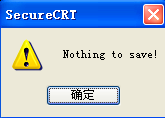SecureCRT Python
学完python后需要学以致用,但平时还真没有这个环境,也不搞自动化,但语言这玩意必需要用,就拿secureCRT来练手吧,也算是和工作擦点边
对话框加按扭
对话框加按扭
CONFIRM_REPLACE = """\ #为数不多的button判断
Do you want to replace the contents of "%(FILE)s" with the selected text?
Yes = overwrite
No = append
Cancel = end script"""
message = CONFIRM_REPLACE % { 'FILE' : "filename" }
prompt = "Replace contents"
buttons = BUTTON_YESNOCANCEL
result = crt.Dialog.MessageBox(message, prompt, buttons)
if result == IDYES:
fileMode = "w"
elif result == IDNO:
fileMode = "a"
crt.Dialog.Prompt( #超级有用的在用户这获取数据的方式 "Save selected text to File:", "SecureCRT - Save selected text to file", "MyFile.txt")
获取log文件名在SecureCRT
tab = crt.GetScriptTab() tab.Session.LogFileName #如果在CRT中设置了log文件名,这个函数可以把它读取出来 #可以直接取到log的文件名获取系统当前的前缀名
SCRIPT_TAB = crt.GetScriptTab() rowIndex = SCRIPT_TAB.Screen.CurrentRow colIndex = SCRIPT_TAB.Screen.CurrentColumn - 1 prompt = SCRIPT_TAB.Screen.Get(rowIndex, 0, rowIndex, colIndex) #获取当前行,当前列的数据,即该服务器的前缀,与waitfor配套 prompt = prompt.strip()
获取打印值
def CaptureOutputOfCommand(command, prompt):
if not crt.Session.Connected:
return "[ERROR: Not Connected.]"
# First, send the command to the remote.
SCRIPT_TAB.Screen.Send(command + '\r')
#输入命令 cmmand 然后回车
# Second, wait for the carriage return to be echoed by the remote device.
# This allows us to capture only the output of the command, not the line
# on which the command was issued (which would include the prompt + cmd).
# If you want to capture the command that was issued, simply comment out
# the following line of code.
SCRIPT_TAB.Screen.WaitForString('\r'
#等待命令输完后,服务器给的回应,这样可以不是获取行,而是获取输出
# Now that the command has been sent, use Screen.ReadString to capture
# all the data that is received up to the point at which the shell
# prompt appears (the captured data does not include the shell prompt).
return SCRIPT_TAB.Screen.ReadString(prompt)
#获取直到prompt出现时的所有数据
屏幕取词
filename = os.path.join(os.path.expanduser('~'), 'output.txt') #~/output.txt
fp = open(filename, "wb+")
screenrow = crt.Screen.CurrentRow - 1
readline = crt.Screen.Get(screenrow, 1, screenrow, 20)
#把当前行的1~20个字符取出来
fp.write(readline + os.linesep)
#把取出的那一行加行尾符写到文件中
写到excel
import os import csv #excel module fileobj = open(filename, 'wb') worksheet = csv.writer(fileobj) worksheet.writerow(items[:2]) fileobj.close(
连接
SSH:
cmd = "/SSH2 /L %s /PASSWORD %s /C 3DES /M MD5 %s" % (user, passwd, host)
crt.Session.Connect(cmd) #ssh -L user password host
Telnet:
crt.Session.Connect("/TELNET 127.0.0.1 2034") # telnet 127.0.0.1:2034
crt.Session.Connect("/S \"" + session + "\"")
#如果这个session在CRT里存在,无论是Telnet还是SSH都能连
调试工具 CRT中的print
crt.Dialog.MessageBox("Nothing to save!")
参考:
http://www.vandyke.com/support/securecrt/python_examples.html


